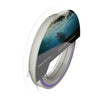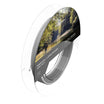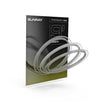
Tom Bell believes in stealth, and that’s the idea behind Sunray fly lines.
Louis has disappeared… which isn’t crazy uncommon during the madness of IFTD, so Murphy and I find a quiet spot to place the tripod and the 50lb suitcase filled with video and audio gear as we listen…. No trademark Louis Cahill laugh to be heard. Where the heck did he go? We’ve got shit to do!
As I make my way around the far end of the second casting pond, something catches my eye. It’s a guy, nimbly hopping around, making casts, and seems to be speaking emphatically about whatever it is that he’s holding in his hands. My curiosity pulls me in that direction and I soon notice that Louis is standing off to the side of the casting pond, nodding, and seemingly listening intently to what this guy is preaching. As I make my way a bit closer, I realize that the gentleman that has stolen Louis from our interview-filled schedule is Tom Bell, owner/fly line designer of Sunray Fly Fishing.
For those that aren’t familiar with Sunray, it is essentially a small, progressive fly line company based in the UK. Their signature fly lines boast “micro thin” diameters that float super high and have very little memory. Tom Bell hopes to help anglers of all skill levels be more successful while on the water with the provided enhancements that he has developed into his batch of fly lines. Tom wanted to create lines that would cast better, float higher, and land with less disturbance on the water, all while catering to a large variety of fishermen. Currently, Sunray Fly Fishing has eleven different lines available on their website, each of which has been fine tuned to excel within various techniques and fishing environments.
Back at the casting pond, my intrigue took over and I had to join in on the conversation. Louis and I spent a good thirty minutes with Tom and a handful of his fly lines. I have to say, we were both impressed with their performance, as were other anglers that we pulled onto the casting pond. The thin diameter of the lines seemed to help them cut through aerodynamic resistance much better, and, when compared to your typical floating line of the same weight, the disturbance on the water upon landing was noticeably much less. Picking the line up off the water was quiet, smooth, and effortless as well.
Fast forward a few weeks, and, thanks to Tom, I have my hands on a Jeremy Lucas Dry line in WF4F. I had what I thought would be the perfect setup for this very line; An Orvis Superfine Carbon 904-4 mated with an Orvis Access III, which had previously been spooled with an old Rio Trout LT that badly needed replacing.
First impressions out of the box, it is MUCH thinner than the Rio WF4F and very slick. I did find it interesting that this line is considered (by Sunray) to have a long head at thirty-three feet. With most fly lines found on fly shop shelves, a long head would be more along the forty-plus feet in length. However, depending on the materials, weight distribution along the length of the line, and the thinner diameter, I can see where this would likely have an impact on labeling the line as a “long” line. The head of the fly line is a dense grey. In fact, it would be easily mistaken for a sink-tip line by others that aren’t privy to what line you’re fishing. Tom Bell believes in stealth, and wanted to incorporate muted colors into his trout lines that are meant for targeting selective, spooky trout. He is from the UK you know. Those muted colors continue into the running line, which interchange between brown, clear, and green. There’s a little bit of memory out of the box, as is with any fly line, but all you’ll need is a little stretch and it becomes as supple as overcooked spaghetti. One of the biggest differences, however, was seen on the reel. The previous WF4F line basically filled the entire spool with 100yds of Dacron backing residing beneath it. Once the Jeremy Lucas Dry line was spooled onto my reel, there was a ton of room left on the spool, giving me a glimpse at the difference in the diameters of the fly lines.
This line is no doubt inspired by the gin clear chalk streams that babble through the U.K., requiring the anglers to bring their A+ game, as well as some patience and some thick skin. After IFTD, I was confident that this line would likely do me some good with the upcoming low and clear waters of Fall and Winter just around the corner. However, with the extreme drought conditions here in the southeast, it’s been on my reel full time and has quickly become my favorite line for my 4wt Superfine. Many of the creeks and rivers are so low that fish are congregating in whatever deep-ish water is available, making them easy to find, but super tough to entice. In many of these runs, fish are scattering in a panic at the lightest of presentations placed upon the water. Knowing this, I was excited to get this line out on a few pieces of my favorite local waters to see what kind of difference (if any) this line could make, and, I have to say, I was very pleased with its performance. The line casts extremely well and loads my Superfine smoothly, without any kick. The slick line will absolutely haul ass through the guides, easily adding several feet to any comparable cast made with a more traditional PVC fly line. Adding to the advantages of the slickness and suppleness of this line, I found that it was less common for me to develop tangles in the running line while reaching out to longer distances. Casts of 50-60ft were wonderfully smooth, with the real sweet spot being right around the 40-50ft mark. Roll casting this line is also something sweet and effortless. This line was designed to do these things well, and truly shines in these scenarios. The landing is quiet, just as I experienced just weeks prior, and pick-up is just as smooth and easy. This line casts like an absolute dream with a single dry (I already can’t wait for Spring), but it also carries dry/dropper and lighter indicator rigs (I use the New Zealand Indicator) with ease as well.
The one characteristic in which this line really flexed its muscle was how quiet it was when it laid out on the water’s surface, as well as during pick-up. Visually, the line even makes less disturbance on the water upon landing. In pressured runs and pools, where I’m used to seeing trout scatter like crazy at the drop of a fly, they weren’t. Now, if I made a crappy cast right on top of a trout’s noggin, it bugged out. However, the difference was that only one, maybe two fish would react to my errant cast. Instead of witnessing complete freak-trout mode, at most I would observe fish simply pushing upstream, or to the far bank after several presentations were made, which afforded me a better chance at hooking up with trout that would’ve likely shutdown otherwise.
Sunray is a name that deserves some attention. And not just because of this single fly line. The entire Sunray mission revolves around making stealthy, micro-thin fly lines with an emphasis on the techniques used to target trout around the world and these lines cover the gamut. I’ve been fishing the Jeremy Lucas line for some time now and it’s proven to be one hell of a line for me. The thinner diameter, combination of materials, and some crafty thoughtfulness seems to have made a significant difference when compared to other lines on the market. Have a conversation with Tom Bell and you’ll get an in-your-face, enthusiastic, and passionate exuberance that is translated into Sunray’s products. Catch one of Tom’s live FB streams and you’ll quickly understand what I’m talking about!
CHECK OUT SUNRAY FLY FISHING AT WWW.SUNRAYFLYFISH.COM!
Justin Pickett
Gink & Gasoline
www.ginkandgasoline.com
hookups@ginkandgasoline.com






























